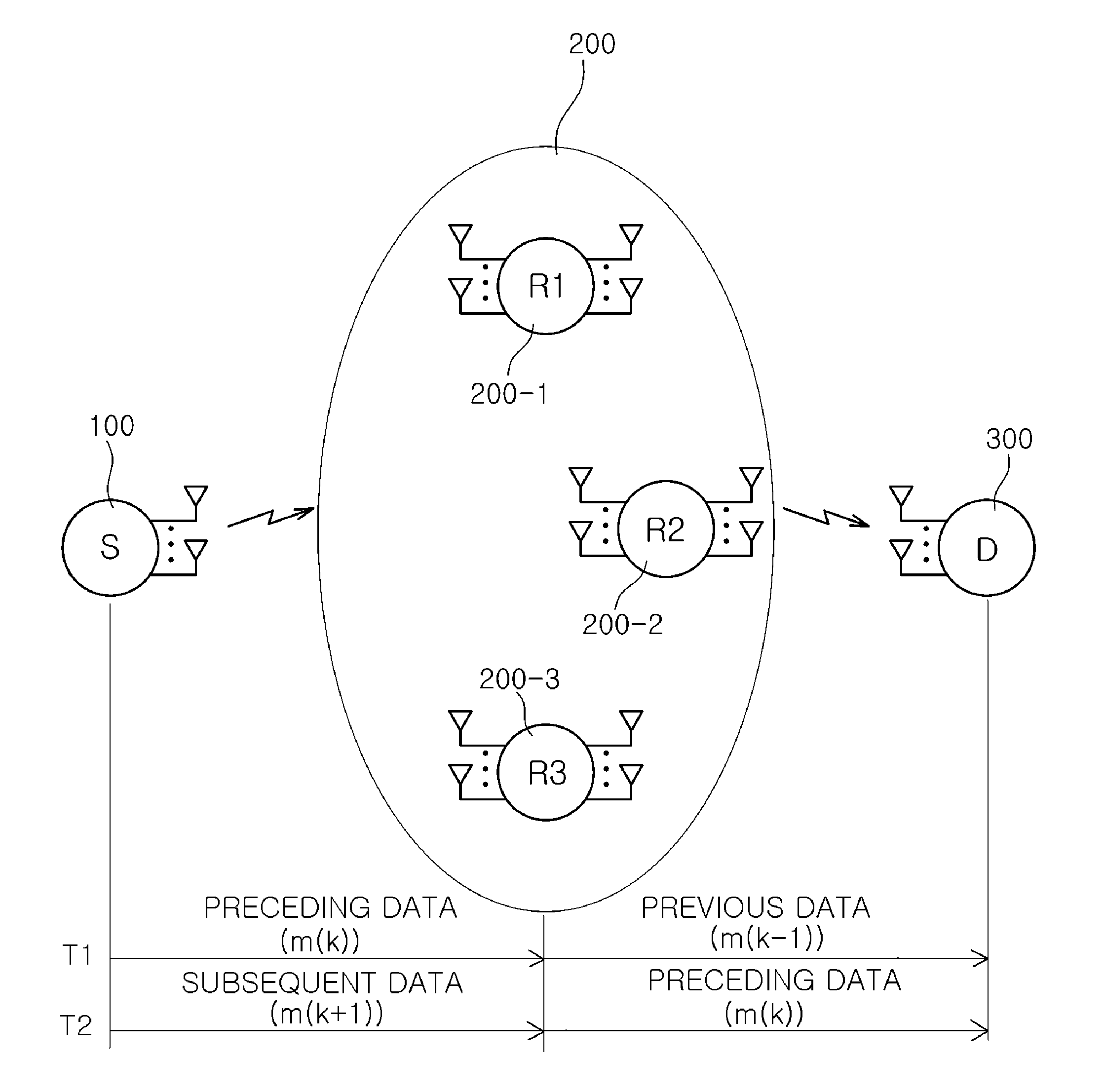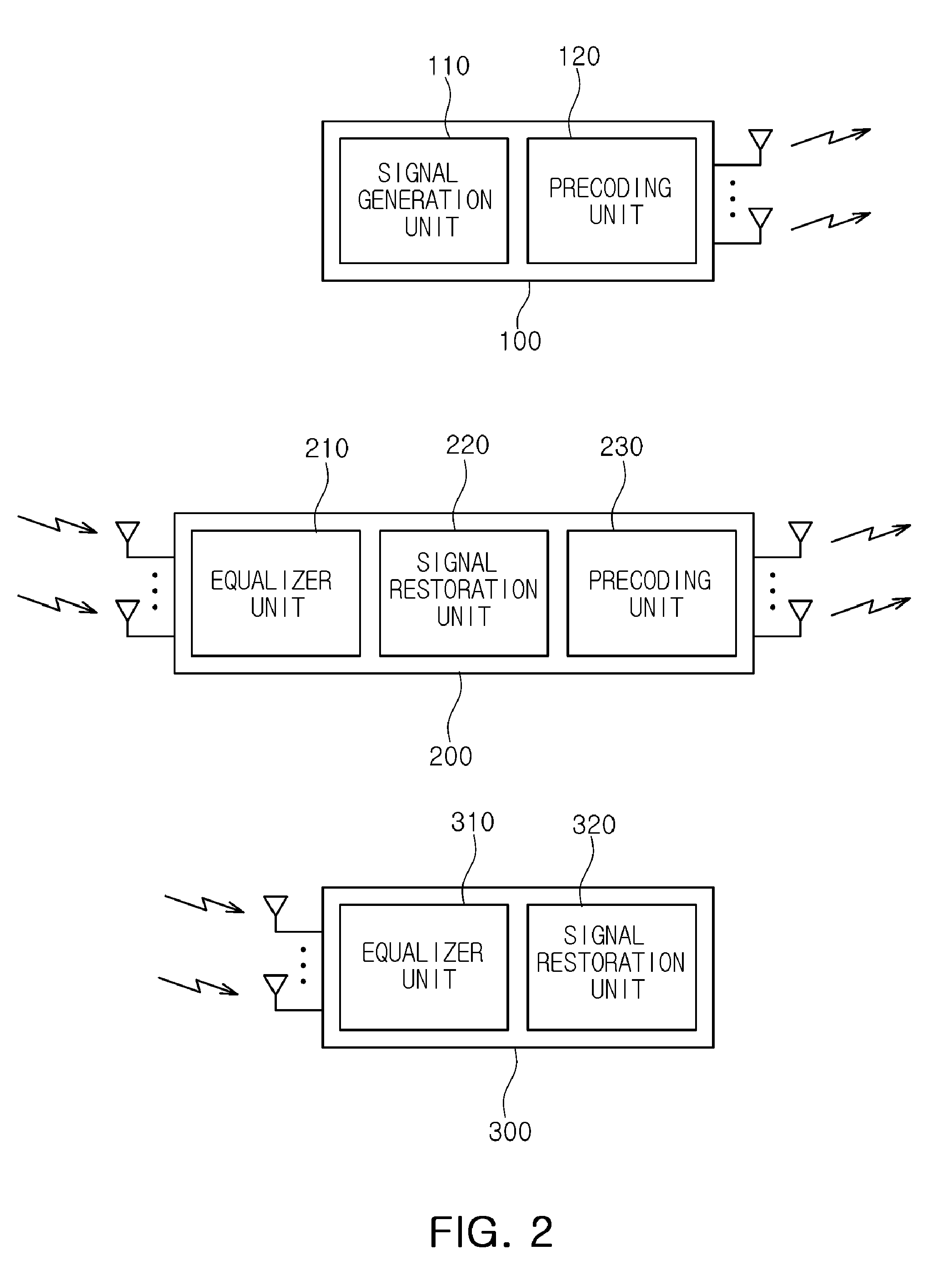Multi-relay transmission apparatus and method using interference alignment
- Summary
- Abstract
- Description
- Claims
- Application Information
AI Technical Summary
Benefits of technology
Problems solved by technology
Method used
Image
Examples
first embodiment
[0047]FIG. 1 is a view showing the configuration of a multi-relay transmission apparatus according to the present invention.
[0048]With reference to FIG. 1, a multi-relay transmission apparatus according to a first embodiment of the present invention may include a source node 100, a relay network 200, and a destination node 300.
[0049]In FIG. 1, the source node 100 may alternately repeat a first phase in which preceding data is transmitted during a first transmission period T1 equivalent to a transmission period during which unit frames can be transmittable at a time in transmitting data frames, and a second phase in which subsequent data that follows the preceding data is transmitted during a second transmission period T2 that follows the first transmission period T1.
[0050]The relay network 200 includes a plurality of relay nodes R1, R2, and R3 receiving data from the source node 100. In the first phase, a predetermined relay node R3, among the plurality of relay nodes R1, R2, and R3...
second embodiment
[0068]FIG. 3 is a flow chart illustrating a process of a multi-relay transmission method according to the present invention.
[0069]With reference to FIG. 3, the multi-relay transmission method according to the second embodiment of the present invention may include a determination step S310, a first phase performing step S320, and a second phase performing step S330.
[0070]First, in the determination step S310, the source node 100 may determine whether it has data to be transmitted.
[0071]In the first phase performing step S320, when the source node 100 has data to be transmitted, it may perform a first phase to transmit preceding data during a first transmission period T1, equivalent to a transmission period during which unit frames can be transmittable at a time in transmitting data frames.
[0072]Here, in the first phase, the predetermined one predetermined relay node R3 among the plurality of relay nodes R1, R2, and R3 may receive the preceding data from the source node 100, and the r...
third embodiment
[0084]FIG. 4 is a flow chart illustrating a process of a multi-relay transmission method according to the present invention.
[0085]With reference to FIG. 4, the multi-relay transmission method according to a third embodiment of the present invention may include a determination step S410, a second phase performing step S420, and a first phase performing step S430.
[0086]First, in the determination state 5410, the source node 100 may determine whether it has data to be transmitted.
[0087]In the second phase performing step S420, when the source node 100 has data to be transmitted, it may perform a second phase to transmit preceding data during a first transmission period T1 equivalent to a transmission period during which unit frames can be transmittable at a time in transmitting data frames.
[0088]Here, in the second phase, the remaining relay nodes R1 and R2, excluding the pre-set predetermined relay node R3, among the plurality of relay nodes R1, R2, and R3, may receive the preceding d...
PUM
 Login to View More
Login to View More Abstract
Description
Claims
Application Information
 Login to View More
Login to View More - R&D
- Intellectual Property
- Life Sciences
- Materials
- Tech Scout
- Unparalleled Data Quality
- Higher Quality Content
- 60% Fewer Hallucinations
Browse by: Latest US Patents, China's latest patents, Technical Efficacy Thesaurus, Application Domain, Technology Topic, Popular Technical Reports.
© 2025 PatSnap. All rights reserved.Legal|Privacy policy|Modern Slavery Act Transparency Statement|Sitemap|About US| Contact US: help@patsnap.com



